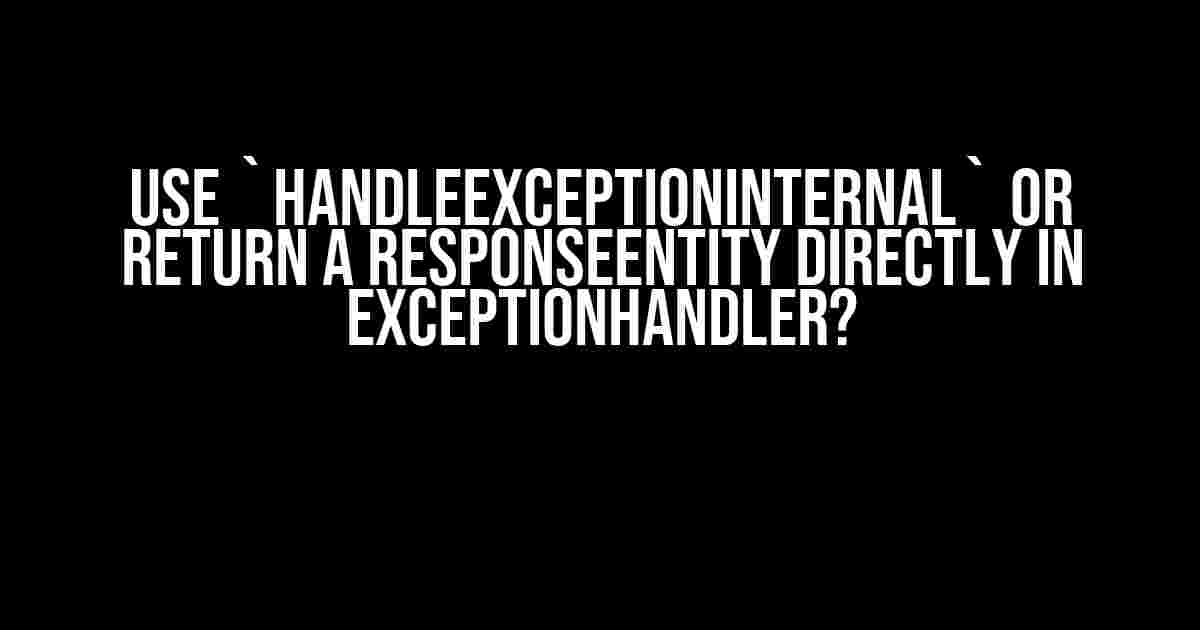When it comes to handling exceptions in Spring-based applications, developers often find themselves torn between two popular approaches: using `handleExceptionInternal` or returning a ResponseEntity directly in the `@ExceptionHandler` method. In this article, we’ll delve into the world of exception handling, explore the differences between these two approaches, and provide you with a clear understanding of when to use each one.
What is an ExceptionHandler?
In Spring, an `@ExceptionHandler` is a powerful annotation that allows you to handle exceptions in a centralized manner. It enables you to catch and process exceptions in a single place, rather than having to repeat the same error-handling logic across multiple controllers. By annotating a method with `@ExceptionHandler`, you can specify a custom exception handler that will be invoked whenever an exception is thrown in the application.
The `handleExceptionInternal` Method
The `handleExceptionInternal` method is a part of the `ExceptionHandlerExceptionResolver` class in Spring. It’s used to handle exceptions that occur during the execution of a request. When an exception is thrown, this method is responsible for resolving the exception and returning a response to the client.
@Override
protected ModelAndView handleExceptionInternal(Exception ex,
HttpServletRequest request,
HttpServletResponse response,
ModelAndView modelAndView) {
// Custom exception handling logic goes here
return modelAndView;
}
The `handleExceptionInternal` method provides a high degree of flexibility and customization. You can use it to return a custom ModelAndView, log exceptions, or even perform complex business logic. However, it can also lead to tight coupling between the exception handler and the controller, making it harder to unit test and maintain.
Returning a ResponseEntity Directly
An alternative approach is to return a ResponseEntity directly from the `@ExceptionHandler` method. This approach is simpler and more straightforward, as it allows you to return a custom response entity that contains the error details.
@ExceptionHandler(Exception.class)
public ResponseEntity<ErrorResponse> handleException(Exception ex) {
ErrorResponse errorResponse = new ErrorResponse(ex.getMessage(), 500);
return new ResponseEntity<>(errorResponse, HttpStatus.INTERNAL_SERVER_ERROR);
}
Returning a ResponseEntity directly is a more modern and decoupled approach. It separates the concern of exception handling from the controller logic, making it easier to test and maintain. However, it may require more boilerplate code, especially when dealing with complex error scenarios.
When to Use `handleExceptionInternal`?
Use `handleExceptionInternal` when:
- You need to perform complex business logic or logging during exception handling.
- You require fine-grained control over the exception handling process.
- You need to return a custom ModelAndView or redirect to a specific error page.
- You’re working with legacy code that relies on ModelAndView-based exception handling.
When to Return a ResponseEntity Directly?
Return a ResponseEntity directly when:
- You need a simple and decoupled way to handle exceptions.
- You want to separate the concern of exception handling from the controller logic.
- You need to return a custom error response with specific headers or status codes.
- You’re building a RESTful API and need to follow industry-standard error handling practices.
Best Practices for Exception Handling
Regardless of which approach you choose, here are some best practices to keep in mind:
- Log exceptions**: Log exceptions with a logging framework like Log4j or Logback to track and analyze errors.
- Use error codes**: Use error codes or error statuses to provide a standardized way of communicating errors to the client.
- Return meaningful error messages**: Return error messages that are informative and helpful to the end-user.
- Test exception handling**: Write unit tests to cover exception handling scenarios and ensure your code behaves as expected.
- Document error handling**: Document error handling logic and scenarios to facilitate maintenance and knowledge sharing.
Conclusion
In conclusion, both `handleExceptionInternal` and returning a ResponseEntity directly are valid approaches for handling exceptions in Spring-based applications. The key is to choose the approach that best fits your specific needs and requirements. By following best practices and considering the pros and cons of each approach, you can write robust and maintainable exception handling code that provides a better user experience.
| Approach | Pros | Cons |
|---|---|---|
| `handleExceptionInternal` | Flexibility, customization, and fine-grained control | Tight coupling, complexity, and legacy code |
| Return ResponseEntity directly | Decoupling, simplicity, and industry-standard error handling | Boilerplate code, limited customization |
By understanding the differences between these two approaches, you’ll be well-equipped to make informed decisions about exception handling in your Spring-based applications.
Final Thoughts
In the world of exception handling, there’s no one-size-fits-all solution. The key is to strike a balance between flexibility, simplicity, and maintainability. By considering the pros and cons of each approach, you can craft a robust and scalable exception handling strategy that meets the unique needs of your application.
Frequently Asked Question
Got stuck on ExceptionHandler? Here are the top 5 questions and answers about using `handleExceptionInternal` or returning a ResponseEntity directly!
What is the difference between using `handleExceptionInternal` and returning a ResponseEntity directly in an ExceptionHandler?
The key difference is that `handleExceptionInternal` allows for more flexibility and customization of the error response, whereas returning a ResponseEntity directly is a more straightforward approach. `handleExceptionInternal` gives you access to the exception, request, and response, allowing you to manipulate the response as needed. On the other hand, returning a ResponseEntity directly is a more concise way to send an error response, but it has limited customization options.
When should I use `handleExceptionInternal` over returning a ResponseEntity directly?
Use `handleExceptionInternal` when you need more control over the error response, such as adding custom headers, setting the status code, or modifying the response body. This is particularly useful when working with complex error scenarios or integrating with external systems. On the other hand, returning a ResponseEntity directly is a better fit for simple error cases where you just need to send a straightforward error response.
Can I use both `handleExceptionInternal` and return a ResponseEntity directly in the same ExceptionHandler?
While it’s technically possible to use both approaches in the same ExceptionHandler, it’s generally not recommended. This can lead to confusion and make the code harder to maintain. Instead, choose one approach that best fits your specific use case and stick to it for consistency and simplicity.
How do I choose between `handleExceptionInternal` and returning a ResponseEntity directly for a specific error scenario?
Ask yourself: Do I need fine-grained control over the error response? Do I need to perform custom logic or manipulate the response in a specific way? If yes, use `handleExceptionInternal`. If not, returning a ResponseEntity directly is a simpler and more straightforward approach.
Are there any best practices for using `handleExceptionInternal` and returning a ResponseEntity directly in an ExceptionHandler?
Yes! Use consistent naming conventions, document your ExceptionHandler, and keep it simple and focused on error handling. Additionally, consider using a separate method for each error scenario to keep the code organized and maintainable. Finally, test your ExceptionHandler thoroughly to ensure it behaves as expected in different error scenarios.
Hope these questions and answers helped you tackle the ExceptionHandler conundrum!


